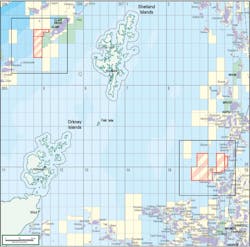BP back in exploratory drilling mode
Britain’s new Chancellor Philip Hammond ignored calls for further tax incentives from the oil and gas industry during his Autumn Statement. However, he did reaffirm the government’s commitment to the various relief measures enacted by his predecessor George Osborne following consultations with the industry.
Oil & Gas UK had called for fresh initiatives, including measures to stimulate exploration. However, as Hammond pointed out, the decline in sterling against the dollar following Britain’s vote to leave the European Union meant that UK North Sea revenues are likely to rise from 2017-18 onwards.
While UK offshore exploration drilling remains sluggish, a few companies have outlined plans for potentially high-impact wells this year, notably BP which last month farmed into five licenses in the Shetlands area. On one of these, operator Statoil plans to drill the Jock Scott prospect in mid-year; around the same time, BP and operator Nexen expect to drill the Craster structure on license P2062. In the southern UK North Sea, BP has joined operator Perenco and Premier Oil in a well testing a potential play-opening deep Carboniferous horizon play several hundred meters below the mature reservoirs produced for decades by the Ravenspurn ST2 platform.
These wells are part of BP’s plan to grow its UK offshore production to around 200,000 b/d by 2020 and to maintain profitable operations in the sector well into the 2030s. One of the main contributors will be the Quad204 redevelopment west of Shetland, which the company aims to bring into production early this year.
Decommissioning on steady, upward curve
Spending on offshore decommissioning is rising in the UK and Norway, according to a report from Oil & Gas UK.Decommissioning Insight 2016found that total expenditure in this sector for both countries was $2.6 billion in 2015, compared with $2 billion in 2014, and represented 5% of the industry’s total expenditure against 2% in 2010. During 2016-25, the report forecasts a decommissioning spend across the UK continental shelf alone of $22 billion.
However, it is a mixed picture, claimed the association’s upstream policy director Mike Tholen, with no general rush to move projects forward. “Some companies are deferring cessation of production,” he said, “as field life has been extended by sustained efficiency improvements; others are delaying activity due to cash-flow constraints; while elsewhere, companies may be expediting decommissioning to take advantage of falling costs in the current downturn.”
Over the next decade the report claims more than 100 UK and Norwegian platforms could be set for complete or partial removal, with more than 1,800 wells scheduled to be P&A’d and around 7,500 km (4,660 mi) of pipelines taken out of service during the same period.
At the same time, the association has been working with the UK government, the MER (Maximizing Economic Resources) UK Decommissioning Board, and the Oil and Gas Authority to develop new technical solutions that could lower the cost of decommissioning. Tholen also pointed out that with 20 Bbbl of oil and gas theoretically still to be recovered off the UK’s shores, it is in HM Treasury’s interest to do what it can to maintain offshore infrastructure in order to avoid premature decommissioning.
OMV exiting Shetlands E&P
OMV has agreed to sell its UK E&P subsidiary to Siccar Point Energy, an Aberdeen-based independent, in a deal valued at up to $1 billion. OMV is a partner in the potential deepwater Rosebank development, operated by Chevron and close to the median line with the Faroe Islands; BP’s Quad204 project; and the undeveloped Cambo, Suilven, and Tornado discoveries. It is also a partner in the Shell-operated high-pressure/high-temperature Jackdaw field in the central North Sea.
Norway, and the Barents Sea in particular, has become of greater strategic importance to OMV. According to a recent Reuters report the company’s Wisting discovery, Norway’s most northerly oilfield find to date appears to hold more than 1 Bbbl following analysis of appraisal wells drilled in 2016, although production may not start until the middle of the next decade.
Lundin Petroleum claims to have discovered 25-60 MMboe in the Neiden structure, 60 km (37 mi) northeast of its Alta field on the Loppa High, after completing an exploration well that had been suspended in November 2015. The semisubmersibleLeiv Eiriksson then mobilized to drill the Filicudi prospect northwest of Alta, where Lundin hoped to prove up to 258 MMboe in a sandstone reservoir thought to be analogous to the Johan Castberg fields.
Spectrum Geo said the Neiden well, which encountered oil and gas in a Permian carbonate reservoir, was targeting the same emerging play on the Loppa High proven by Lundin in the Alta oil discovery, 60 km (37 mi) to the southwest and by OMV at the Gohta field, also to the south.
According to Spectrum, the confirmed karstification of the reservoir should also enhance the reservoir properties. All three finds are thought to have originated from a combination of Palaeozoic and Mesozoic source rocks. Lundin has identified numerous other prospects across the Loppa High, some of which it plans to drill later this year.


